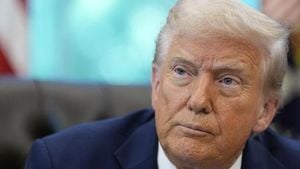Intel Corporation announced the abrupt resignation of its CEO, Pat Gelsinger, this week, leaving industry insiders and investors discussing the future and direction of the tech giant. Gelsinger's sudden exit arrives amid mounting challenges for the semiconductor company, including steep declines in stock price and increasingly fierce competition from rivals like Nvidia and AMD. Speculations surrounding the decision suggest it stemmed from internal conflicts within the company's board rather than just market pressures.
News circulated quickly after Gelsinger's departure, which was officially labeled as retirement. Yet, it appears the resignation was far from voluntary—it followed tensions with Intel’s board over his strategy to regain market share lost to competitors. This included failing to launch promised products and turning around the company's fortunes. The board reportedly presented Gelsinger with the ultimatum to either resign or complete his transition out of the role.
Since Gelsinger’s departure, Intel has named two interim CEOs to lead the company as it searches for his successor. Michelle Johnston Holthaus, who oversees product operations, alongside David Zinsner, the chief financial officer, now stand at the helm. This is not the first time Intel has found itself grappling with leadership changes, as Gelsinger himself had previously taken over from Bob Swan—another tumultuous period marked by the company's struggle to keep pace with industry advancements.
Under Gelsinger's leadership, which began just three years ago, he sought to reposition Intel by investing heavily in new factories and aiming to become not just a manufacturer but also a significant player in contract chip production. He ambitiously planned to create new manufacturing sites across the U.S. and Europe, hoping to restore Intel's once-dominant role as the go-to chipmaker. Unfortunately, high operating costs and technical difficulties thwarted many of those goals, putting his plans—and his job—in jeopardy.
Despite Gelsinger’s exit sparking initial rallies in Intel’s stock price, the optimism quickly faded, and shares plummeted once more as investors processed the company's uncertain future. Analysts expressed mixed feelings. Claus Aasholm from Semiconductor Business Intelligence emphasized the magnitude of Gelsinger’s removal, saying, "Axing Pat Gelsinger is a massive loss and could cost Intel its life," indicating the deep ramifications of this sudden shift.
While several external candidates are reportedly under consideration for the CEO position, two names have emerged prominently: Matt Murphy, the CEO of Marvell Technology, and Lip-Bu Tan, who previously served on Intel's board. Murphy brings extensive experience, having led Marvell's operations since 2016, and Tan has significant industry knowledge, being the former CEO of Cadence Design.
Murphy's background as Marvell’s leader, along with his previous roles at Analog Devices, positions him as someone capable of tackling Intel's challenges head-on. He has publicly committed to focusing on Marvell, stating during recent earnings calls, “I’m 100% focused on Marvell,” raising questions about his willingness to take on the Intel role. Meanwhile, Tan's return appears complicated by past conflicts with Gelsinger over strategic direction.
Industry analysts stress the urgency for Intel to find a strong leader soon. Some—like Patrick Moorhead, CEO of Moor Insights & Strategy—have criticized the board's handling of Gelsinger's exit. He asserted, "This one was so easy to predict. Board ghosts the Intel Corporation CEO without an explanation or replacement and the stock plummets," demonstrating the frustration many feel with the board’s management approach during this turbulent time.
Poor financial results have laid bare Intel's struggles. The company reported significant operating losses, with some estimating up to $5.8 billion just this quarter alone. This continues to exacerbate investor anxieties, particularly as the overall semiconductor industry thrives amid technological advancement—most prominently, artificial intelligence and machine learning, areas where Intel finds itself trailing behind competitors.
Gelsinger's grand plans included launching Intel’s own line of AI chips, termed Gaudi, to directly compete with Nvidia’s successful offerings. Unfortunately, even those ambitions faltered, as Gelsinger acknowledged last month the firm would likely miss its $500 million sales target for the Gaudi 3 line due to software issues.
The internal division over the company's strategic direction now fuels speculation over Intel’s future. With tumultuous circumstances surrounding Gelsinger's ouster, industry voices wonder whether restructuring the firm entirely, including potentially spinning off the foundry division, is the answer to restoring market confidence. Some experts advocate for simplifying Intel's operations to focus solely on semiconductors rather than also attempting to serve as a foundry for other companies.
Sending shockwaves through the chipmaking world, Gelsinger’s exit symbolizes not just the fall of Intel's recent efforts but also the uncertainty enveloping its future. Intel’s board will have to make swift and strategic choices if the once-dominant chipmaker hopes to regain lost footing and deliver meaningful returns to its investors.
Looking forward, industry watchers speculate on whether those who take the reins post-Gelsinger can usher Intel back to its programming roots or if it will sink under the weight of its past miscalculations. The stakes are high for the company, which must navigate turbulent waters amid fierce competition, technological change, and financial pressure.



